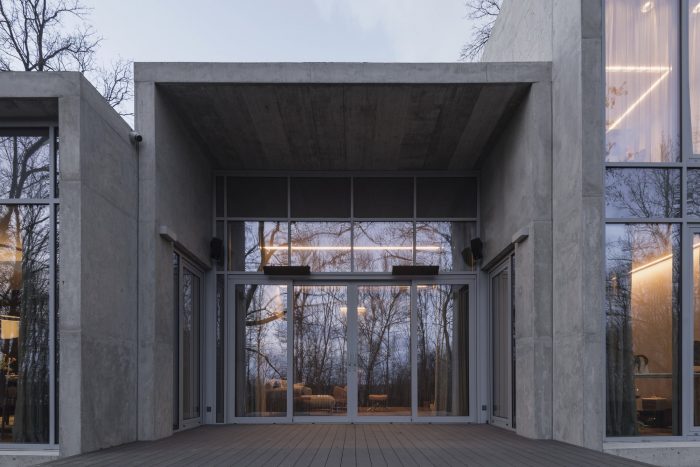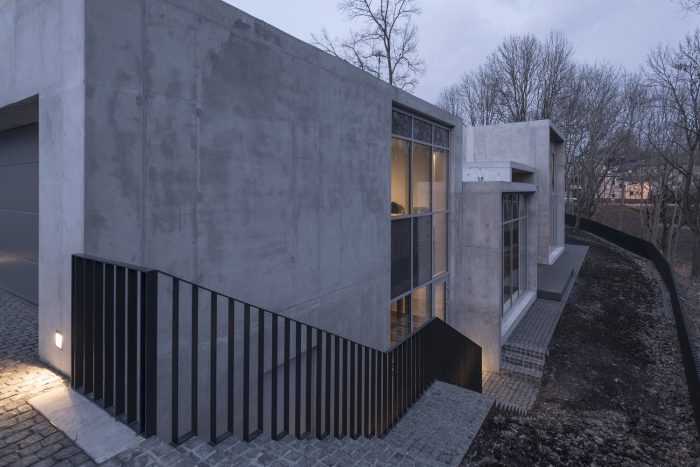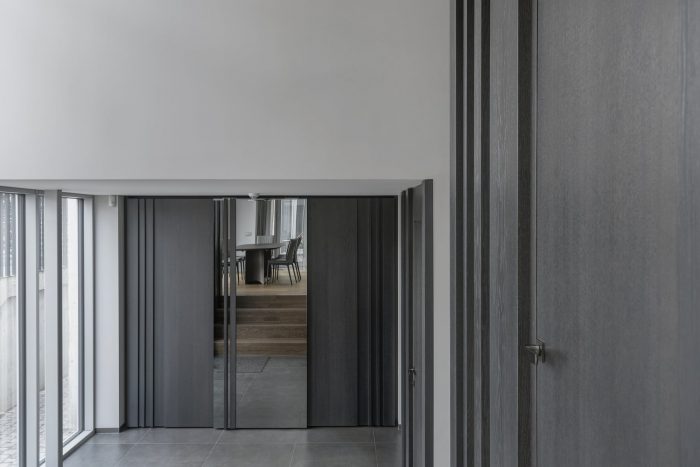这座富有表现力的建筑,由独立的相互连接的模块设计而成,位于历史悠久的Zaliakalnis的风景优美的斜坡上,可以看到市中心的全景。该地块两边是生长在斜坡上的树木,就在这里–通往市中心的考卡斯阶梯。位于战时独立的立陶宛前总理Juozas Tubelis的别墅内的艺术体操馆就在附近。
The expressive building, designed from separate interconnected modules, is located on the picturesque slope of the historic Zaliakalnis site, which offers a panoramic view of the city center. The plot is surrounded on two sides by trees growing on the slope, right here – Kaukas stairs to the city center. The art gymnasium, located in the villa of the former Prime Minister of independent interwar Lithuania Juozas Tubelis is nearby.
非常密集的城市建筑情况。强大的自然影响,因为该地块位于斜坡上,在斜坡的最顶端,可以看到城市的全景。这种厚度不仅是由于自然,和文化,也是由于情感方面,因为一旦别墅被设计成一个完成的构图,侧屋和另一个房子就不必在这里。随着时间的推移,情况发生了变化,形成了一个独立的地块,建筑师被委托创造一个不同的方法–尊重这个环境,创造一个现代建筑,而不模仿它是这个别墅的一部分,但创造一个新的建筑而不掩盖历史上的建筑。
Very dense urban architectural situation. Strong natural influence, as the plot is on a slope, at the very top of it, which offers a panoramic view of the city. That thickness is due not only to the natural, and cultural but also the emotional aspect, as once the villa was designed as a finished composition, the side house and another house did not have to be here. Over time the situation changed, a separate plot was formed and the architects were entrusted with creating a different approach – respecting this environment, creating a modern building without imitating that it is part of this villa, but creating a new building without obscuring the historic ones.
它不仅是一个历史悠久的地方,也是一个不断变化的地方,因为在秋天,树叶幕布捕捉到了全景,然后你会感觉到生活在森林里。评估了地形的极度动态轮廓,建筑师试图设计一个能有机地流进地块的结构,由小的模块元素建成,就像这些单独的元素洒在斜坡上一样。建筑物的墙体被翻倍并变薄,这样看起来就像建筑的每个体量都是放在旁边的独立元素。一个体量是由四个独立的体量构成的,里面的空间重叠、交错,变得动态。
It is not only a historical place, but also a changing one, as in autumn the leaf curtain captures the panorama and then you feel like living in the woods. Assessing the extremely dynamic profile of the terrain, the architects sought to design a structure that would organically flow into the plot, built from small modular elements, as if those individual elements were sprinkled on the slope. The walls of the building were doubled and thinned so that it looked like each volume of the building was a separate element placed next to it. A single volume is built of four separate volumes, inside which the spaces overlap, interlock, and become dynamic.
由于人们很难下楼,因为它与地下室、寒冷和不舒适联系在一起,这使得复杂的建筑情况的情感方面更加复杂。在这种情况下,我们有一种情况,我们看到自己房子的屋顶,所有的生活都像下面的露台一样进行着。这是一个地板很低的房子,一个有一面墙在地下的房子,一个有混凝土墙的房子。这些确实是心理上的大挑战。这是一个实际上没有地盘的房子。只有一个狭窄的部分,但这个地块的面积并不缺乏,一切都在这里。
The emotional aspect of the complex architectural situation is compounded by the fact that it is difficult for people to go down the house because it is associated with basements, cold, and uncomfortably. In this case, we have a situation where we see the roof of our own house and all life goes on like a terrace below. It is a house with a low floor, a house with one wall underground, and a house with concrete walls. These are really psychologically big challenges. This is a house that doesn’t actually have a plot. There is only a narrow section, but the area of that plot is not lacking, everything is here.
为了不伪造历史,住宅的设计是以一种对比的方式进行的–让人明白这是一个时代的建筑。因此,这座特殊的建筑以混凝土的外墙来欢迎,表达了它的自然之美,其粗糙的工业纹理被玻璃所软化,与它的轻盈和脆弱形成对比。
In order not to falsify history, the residential house was designed in a contrasting way – to make it clear that it is a building of this time. Therefore, the building of exceptional architecture welcomes with the concrete façade, expressing its natural beauty, whose rough industrial texture is softened by the glass, contrasting with its lightness and fragility.
而混凝土虽然是一种自然、中性的材料,但与附近的战时建筑,如尤扎斯-图贝利斯(Juozas Tubelis)的别墅形成了鲜明的对比,后者是粉刷的,色彩斑斓。这是一个非常电气化的地方,无论是自然的还是文化的,所以我们的建筑师团队的任务是设计一个能创造一种气氛的房子,使房子有自己的某种精神,看起来好像是一个五维空间。挑战是通过把房子降低到低矮的露台上,确保没有感觉到身后有土。目的是创造一种舒适的感觉,以及在家里时的安全感,并且整个城市的景色–自然、救济、城市、中心都在你的眼前。
And concrete, though a natural, neutral material, contrasts sharply with the interwar architecture nearby such as Juozas Tubelis’ villa, which is stuccoed and colorful. It is a very electrified place, both naturally and culturally, so our team of architects had the task of designing a house that would create a mood so that the house would have a certain spirit of its own, to appear as if it were a fifth dimension. The challenge was by lowering the house to the low terrace to make sure there is no feeling that there is earth behind you. Aim to create a feeling of coziness, and security while being at home and that the whole view of the city – nature, relief, city, center is in front of your eyes.
建筑体量的想法也被编入房屋内部空间的方案中。这些不同的层次,这种动态在房子的外部和内部都会重复。我们看到外部的体积从外面传到里面。这就像我们落入某种层次的前提下:有一个低的空间,然后是一个高的垂直空间,这个空间变化,它上升,它下降,它压缩。建筑物的设计方式允许它被创造出来。打开这个视野,这在这里是非常重要的。
The idea of the volume of the building was also programmed in the scenario of the interior space of the house. Those different levels, that dynamic repeats both outside and inside the house. We see the external volumes passing from the outside to the inside. It is as if we fall into a certain hierarchy of premises: there is a low space, then a high vertical, that space changes, it rises, it lowers, it compresses. The way the building was designed allowed it to be created. Opening that view, which is very important here.
Architects: Architectural Bureau G.Natkevicius & Partners
Area : 289 m²
Year : 2020
Photographs :Lukas Mykolaitis
Manufacturers : BOSE, Performance in Lighting, Yawal
Lead Architects : T. Jokubauskas, A. Rimšelis, A. Natkevičiūtė, G. Natkevičius
Structural Engineer : A. Ražaitis, G. Vaičiulis
Interior Design : S. Vaitekūnienė
Project Managers : A. Sapkienė, M.JUCIUS, T.JŪRAS
City : Kaunas
Country : Lithuania





























